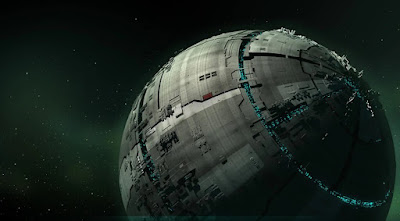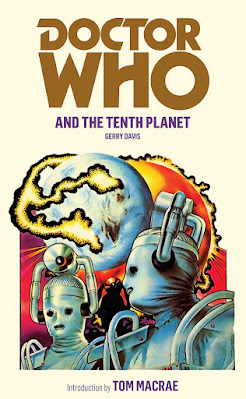"Abyss Station" is an installment of the "Living Campaign," a set of free Star Trek Adventures given away on the Modiphius web site. I had it in mind as one we might do during my first STA campaign, but I never got around to it. A few things appealed:
- It had an ancient mysterious structure, something that would tie well into the ongoing story arc of that campaign.
- I read some comments about the mission somewhere (maybe on the STA subreddit) that made it sound fun.
- One of my players in that campaign was always complaining that his character's Focus in "Philosophy" was useless, and this featured a philosophical debate.
When it came time to plan my new campaign, I realized it would slot well into my new story arc as well, tie into a new player's Focuses, have some good exploration/diplomacy stuff, and allow for the splitting up of the characters.
Thus it became the second episode of...
"Captain’s Log, Stardate 53820.4. The Diversitas under my command has successfully completed its first mission, and we have resumed our journey through the Ekumene sector. Word from Ryuku indicates there have been no more Rock Beast attacks. However, the mysterious android corpse found among the members of Return to Harad is befuddling my crew…"
Planning the Mission
The premise of "Abyss Station" is that the player ship is summoned by Abyss Station, a Federation science outpost in the Omega Draconis system. The Omega Draconis system has a black hole for a primary (Omega Draconis A*, pronounced a-star), whose radiation jets provide dim light and heat to its sole planet, Omega Draconis I, inhabited by a prewarp civilization, the Ithik. The black hole is also orbited by an ancient alien facility of unknown origin. Abyss Station sent a landing party down to the facility but it didn't come back, and now the black hole is rotating, its radiation jets about to come into alignment with Omega Draconis I, which will render the planet uninhabitable.
The mission-as-written assumes your players will split up into two groups, one to explore the alien facility, seeking the away team and a cause as to why the black hole started rotating, and the other beaming down to Omega Draconis I to figure out if the Ithik can be evacuated.
There are some STA missions where I make lots of changes, either because I have a better (for me and my players) idea or because I want to tweak it to fit into my narrative. I actually did not make a lot of changes to this one, mostly just in the set-up. At the end of their first episode, my players discovered that one of the members of the terrorist cell they'd been battling was an android; this episode opened with them investigating the android (which was deactivated) to determine its origin. They found it used a mysterious element in its construction, and that the only other place in the sector known to contain that element was the alien facility orbiting Omega Draconis A*. I then laced some further clues into the episode; one of its reveals is that the Ithik have artificial mitochondria, and I had those too contain the mysterious element.
 |
| Omega Draconis A* (image of Sagittarius A* from New Scientist) |
- a room with an ancient computer interface that they could try to get working again (if they did, it would reveal a video detailing the origin of the facility)
- a room with a hostile robot and a chasm they'd have to cross, as well as an Extended Task to unlock the door to get out
- a room with an injured member of the previous Starfleet team to visit the facility, who was in imminent danger of death but could not be stabilized in the room; I would do an Extended Consequences track that they would have to beat to get out
Additionally, I was going to lose one of my players for six weeks, so I worked that into the narrative. Joel, who plays the science officer, was going to command the away mission to the facility. His backstory included the idea that his body once got flooded with tachyons, sending him through time; I planned that an inopportune moment, a device in the alien facility would recharge him those tachyons and send him six weeks into the future... but where!?
A lot of elements of the mission as written fit well into my players' established characters and personalities. For example, the players have to convince the Ithik mayor there really is a threat requiring evacuation, and they need to go through his ministers; one suggested person is the Minister for Athletics, who challenges a player character to physical competition. Our security chief mostly relies on her brains and thus has a low Fitness score, setting up an interesting challenge! And our executive office has a backstory that she used to be a dancer, but struggled to fit this into her Vulcan need to suppress emotion; I also made a Minister for the Arts who could challenger her to a dance-off.
As always, I changed the title to be more pretentious. In this case, "A Terrible Autonomy." I also came across a quotation by Thomas Henry Huxley including the word "abyss" which I decided would make a good motto for Abyss Station, explaining both its somewhat portentous name and the logic of T'Lah, the villain of the story: “Sit down before fact as a little child, be prepared to give up every preconceived notion, follow humbly wherever and to whatever abysses nature leads, or you shall learn nothing.”Playing the Mission
I have seven regular players, plus Toren who steps in whenever the numbers are low; we also ended up with a visitor to one session. He just came to watch, but the number of players was such that I actually rolled up a support character for him to play.
- Ryan as Rucot, captain (sessions 1-2)
- Debi as T'Cant, first officer (3)
- Kenyon as Nevan Jones, engineer (1-3)
- Claire as Mooria Loonin, pilot (1-3)
- Austin as Frector, security chief (2-3)
- Forest as Alita Faraday, medical officer (1, 3)
- Joel as Oliver Johnson, science officer (1)
- Toren as Tronnen, counselor (1, 3)
- [plus special guest star] Scott as Anthor, anthropologist (2)
I paced this one pretty well, with one session per act. In the "teaser" for the first episode, my players had a lot of questions about the android I had not anticipated! But I did get them on track with where I wanted them to go. I got a little bit of RP out of them when Oliver, nervous about how his first mission had gone, went to the ship's counselor. What resulted was a funny scene, where Tronnen, the Klingon counselor, advised the scrawny nerd that what he really needed to do was hit the holodeck and battle ten Klingon warriors for a good warm-up, and then twenty for a real workout.
 |
| the alien facility in the Omega Draconis system (all images of it are from a game called Planetary Annihilation) |
The mission as written, because it is TOS era I suspect, has the away team to the planet just beaming down and announcing who they are. But I really really hoped my players would surgically disguise themselves as Ithik... and indeed they did. This made for a very funny scene where the seemingly primitive Ithik called them out for who they were... and a delightful last note for the session where the Ithik mayor clapped Captain Rucot on the back and asked how much he liked playing games. As Ryan pointed out, playing games with aliens never goes well in Star Trek!
In the second session, I alternated between the away teams on the planet and the facility, which went very well. The planet team first went through the Minister for Philosophy—whose belief was that no one existed other than the Ithik and thus the away team was a figment of the Ithik's superior imagination! But they managed to convince him if that was true, there could be no danger in evacuating the planet. Frector then had her showdown with the Minister for Athletics, getting good use out of her Value "Anything You Can Do I Can Do Better." The mission as written says the players need to convince three ministers to win over the mayor, but my players came up with a scheme to win over the mayor by playing to his obsession with games, and inviting him onto the holodeck. They debated a bit what the game should be (dabo?) but eventually realized they needed something new to him, and settled on an interactive murder mystery. Sherlock Holmes was suggested, but I pointed out that a Cardassian captain was far more likely to suggest an enigma tale, where everyone is guilty but the state needs to figure out of what.
Unfortunately, Debi was sick, so there could be no encounter between T'Cant and the Minister for the Arts as I'd planned.The Ithik were great fun to play, and my players seemed to get a big kick out of them. Over-the-top, arrogant, complacent, friendly, and exuberant. Their population numbers in the hundreds, but they have dozens of ministers in the government; when the players asked if they knew anything about the facility, they said there were theories from hundreds of competing cults. ("Oh, everyone around here belongs to two or three cults, you know.")
Meanwhile, the away team on the facility had a good time. Forest, playing Faraday, had to back out at the last minutes, but was willing to let the others play her character while she was gone. They did good with the video room. The Extended Consequences challenge—my first attempt at this—turned out to be a little too easy but they did well at it too.
In the last session, things converge, as the player ship evacuates the planet, heading to Abyss Station to drop the Ithik there, only for Abyss Station's commanding office, T'Lah, to steal a shuttle in an attempt to use the alien facility to fire a black hole at the Dominion homeworld! The players have to stop her from both ends.
They did great! The players on the facility used their controls to lock T'Lah and the two Ithik helping her into a room; Frector and Tronnen meanwhile bluffed her into thinking they were sympathetic to her cause.
 |
| Abyss Station (screenshot from DS9's "Blaze of Glory," I think) |
Claire complained at the mission's end that though they had solved the immediate crisis, they didn't have any clear answers—only more mysteries! What was the relationship between the Haradin android, the Ithik, and the Engineers? Well, some things would have to remain for future episodes...
This was a fun one overall, and like I said, worked with minimal tweaking. Highly recommended.
Star Trek: Ekumene:
- "Patagon in Parallax"
- "A Terrible Autonomy"
- "Stinks of Slumber and Disaster"

















